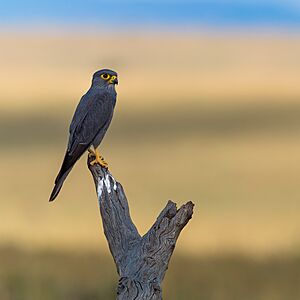Grey kestrel facts for kids
Quick facts for kids Grey kestrel |
|
|---|---|
 |
|
| Grey kestrel at the Maasai Mara, Kenya | |
| Conservation status | |
| Scientific classification | |
| Genus: |
Falco
|
| Species: |
ardosiaceus
|
The grey kestrel (Falco ardosiaceus) is a type of falcon found in Africa. It's a bird of prey, meaning it hunts other animals for food. This bird is closely related to the banded kestrel and Dickinson's kestrel. Sometimes, these three birds are grouped together in a special family group called Dissodectes.
Contents
What Does the Grey Kestrel Look Like?
The grey kestrel is a small, strong kestrel. It has a big, flat head and short wings. When the bird is resting, its wings don't reach past its tail.
This kestrel is about 28 to 33 cm (11 to 13 inches) long. Its wings can spread out to 58 to 72 cm (23 to 28 inches) wide. It can weigh up to 300 grams (about 10.5 ounces). Female grey kestrels are a bit bigger and heavier than males.
Adult grey kestrels are mostly dark grey. Their wingtips are darker, and they have faint dark stripes on their bodies. Their flight feathers (the long feathers on their wings) have light bars. Their feet and the waxy part above their beak (called the cere) are yellow. They also have bare yellow skin around their eyes.
The sooty falcon looks similar to the grey kestrel. But the sooty falcon has a rounder head and longer wings. It also has less yellow skin around its eyes.
Young Grey Kestrels
Young grey kestrels, called juveniles, are browner than the adults. Their cere and the skin around their eyes are greenish. Young Dickinson's kestrels look a bit like them, but they have a striped tail and more stripes under their wings.
Kestrel Sounds
Most of the time, the grey kestrel is quiet when it's not breeding. But during the breeding season, it makes a loud, chattering call. It also makes a rattling whistle sound.
Where Do Grey Kestrels Live?
Grey kestrels live in savannas (grassy plains with scattered trees), open woodlands, and clearings in forests. They especially like areas with palm trees, often near water. You can often spot them sitting on exposed tree branches, telephone poles, or wires.
They are found across West and Central Africa. However, they don't live in very thick forests, like parts of the Congo Basin. Their home range stretches east to Ethiopia and the western parts of Kenya and Tanzania. To the south, they reach northern Namibia and Zambia. Sometimes, a few birds, called vagrants, have been seen in Malawi. The total area where they live is huge, about 12 million square kilometers.
In West Africa, these birds sometimes move north during the wet season. Then they move south again when the dry season arrives.
How Grey Kestrels Live and Reproduce
The grey kestrel is a crepuscular bird. This means it is most active during dawn (early morning) and dusk (early evening). It usually hunts from a high spot, like a tree branch. Sometimes, it will hover in the air to look for food.
What They Eat
Grey kestrels mainly eat insects, lizards, and small mammals like bats. They also catch birds, amphibians (like frogs), and worms. They usually catch their prey on the ground. Interestingly, they sometimes eat oil palm nuts. This is unusual because most birds of prey don't eat plants.
Reproduction and Life Cycle
Grey kestrels breed at different times depending on where they live. In the northern parts of their range, breeding happens from March to June. In the south, it's from August to December.
When a pair is ready to breed, they fly together in the sky. The female usually lays her eggs in the nest of a hamerkop (another type of bird). Most often, they use an empty hamerkop nest. But sometimes, they might even force the hamerkops out of their nest! Grey kestrels might also use the nest of another bird or a hole in a tree.
A female kestrel lays two to five eggs in a clutch (a group of eggs laid at one time). The eggs are whitish with reddish or brown marks. The parents keep the eggs warm (this is called incubation) for 26 to 31 days. The young birds are ready to fly (this is called fledging) after about 30 days.


